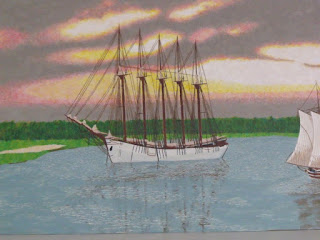It shows the marsh shoreline of Yarmouth Port, Massachusetts, with some of the town's historic architecture at left, and the lighthouse at Barnstable Beach Point on the right. There are two coastal fishing schooners under sail, and the five-masted cargo schooner Harwood Palmer at anchor in between them. The ship on the left is after an 1864 photograph taken in Canada. The ship on the right is after drawings by William Bradford and Albert van Beest.
Harwood Palmer was run aground by her captain in January of 1905, during a winter storm. She had first put in to Provincetown, but her anchor chains parted. The captain knew that there were sand flats, but few rocks, off of Yarmouth Port, so he steered her there, to minimize damage to the hull. He succeeded, but it took until May 1905 to get her free of the sand. Here is a close-up of Harwood Palmer:
The buildings on the left are, from left to right (or east to west): the onion steeple dome of the former Congregational Church, since dismantled, at what is now the Yarmouth Port playground; the current Congregational Church, built in 1870; the cupola of the Colonial House Inn; the steeple of the Strawberry Hill Meeting House, a former church renovated with considerable love by the much-admired theatrical set designers Herbert Senn and Helen Pond; and the New Church, also know as the Swedenborgian Church.
It is NOT an accurate rendition of the town. This was necessary to incorporate all of the desired buildings and ships. Today, it would be difficult to sail ships of this size out of Bass Hole (which would be to the left side of the painting), because so much sand has filled into the channel there. The coastline today is forested much as I've depicted it here, but in 1905 the area was mostly farmland. The onion dome hasn't been there since sometime in the 1800s, and that church is entirely gone now. Strawberry Hill is actually higher than the New Church, and of the four extant structures, only the Congregational Church is visible from the shore. And Barnstable Beach Point Light would be at least 6 feet or so beyond the right-hand side of the image.
The painting is irregular, about six feet wide by approximately fifteen inches on the left side, and approximately seventeen inches high on the right side. This is because of the dimensions of the existing space, over a fireplace in a historic sea captain's home. This fireplace is in a part of the house dating to circa 1670, so there are few truly straight lines or right angles. The painting is acrylic on masonite.
I must also extend my thanks to the Historical Society of Old Yarmouth, for collecting and archiving so much information that was necessary for my research, and to the New Bedford Whaling Museum, which many years ago hosted an outstanding exhibition of the work of William Bradford. Publications from these two institutions provided valuable research material and inspiration for this project.
This next piece is titled 潮州歌剧院之王 / The King of the Teochew Opera. I lived in Thailand from 2010 to 2014, saw Chinese Opera there for the first time, and absolutely fell in love with it. I couldn't understand the language, so I'm learning Chinese on my own now. It's slow going - there's just a lot of information to memorize for the writing system - but no matter. All learning is worthwhile, no matter how long it takes.
And last, but not least, and back to A Christmas Carol, a scene from Stave 4, showing the three people who have pilfered Scrooge's deathbed belongings and are taking them into a London slum to sell them to a dealer in things unsavory. I used conté crayon on a pencil underdrawing. In order to get the detail on the figures, I made the image bigger than usual, 15" x 15" instead of 7.5" x 7.5". The text doesn't mention stairs, but does mention arches. I took the stairs-and-arches motif from da Vinci's Adoration of the Magi,turning the Three Wise Men into the pilferers, and the barn and manger into Old Joe's shop.



